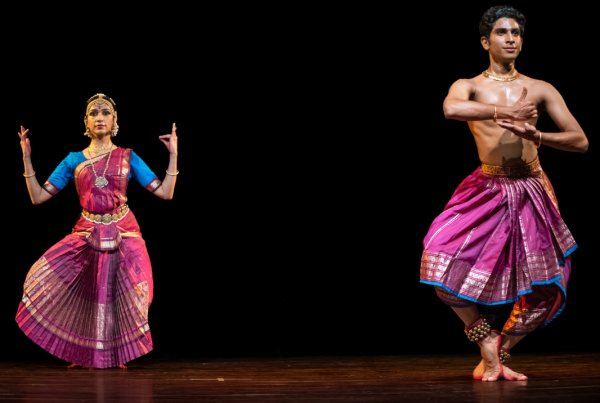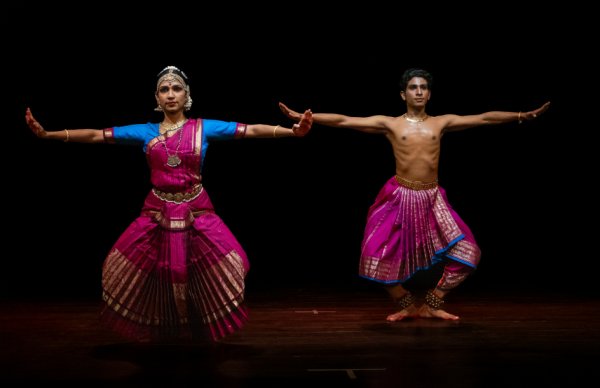
|   |

|   |
Iti Margam - SJS Photos: Joseph S Kumar July 19, 2022 Iti Margam, a collaborative showcase by Aruna Bhargavi and Jagadishwar Sukumar, senior students of Ramaa Venugopalan, was presented on the 1st of July 2022 at Seva Sadan, Bengaluru. Working with the flow of the traditional Bharatanatyam repertoire, they presented an honest, well-ideated evening of dancing exploring between them the joy, strength, and purpose of the Margam - rooted in the path with endearing friendship. Often, dancers tend to approach the Margam format with quixotic whims of reinventing wheel to create distinctive and presuming unimagined explorations. The glorious days of the thematic Margam presentation is well behind us, with dancers finding the pressing requirement to create a brand for themselves, an identity that is distinctive and relevant. Arbitrary markers like Instagram followers and likes bestowing clout, visibility, and undue credibility to a certain fringe, to perform and stay relevant is beyond hard work for young upcoming artists. It's easy to compromise the principles and tradition with odds stacked up against them. This pushes many dancers to run on fumes, to constantly create content from a place of pretensions, barely giving them time to enjoy their choreography.  Iti Margam, however, stuck to its ethos and made a noticeable impression. The decision to forego tiresome items like the Todayam, Pushpanjali, Shloka often performed in the perfunctory with the solitary of appeasing the traditionalists was admirable. The duo cut right to chase and brought to stage a brisk, refreshing Alarippu in mishra chapu talam. Sharp and strong body work with pleasing moments of joy and friendship throughout, it perked up the audience up for the evening's recital. Vazhuvoor Ramaiah Pillai's Keeravani Jathiswaram served as a highlight in choreography deviating to the individual paths of the duo and eventually coming together in a confluence rooted firmly in the Vazhuvoorar Baani. The idea was well executed, notably breaking all expectations - Jagadishwar relayed a sparkling string of Marga Karanas, a path he has been passionately exploring. His graceful, intuitive flow of the movements more than made up for the lack of finer awareness of the technique. Aruna displayed her strong foothold to handle the nimble traditional adavus, secure in her resolve, and unflinching in conviction of her chosen path. The Jathiswaram was a visual celebration, with the lovely pink and blue costumes adding to the vibrance. There was semblance of filmy grace, reminiscent of the actress Padmini and Kumari Kamala. Establishing the musical landscape of the Varnam, an eargasmic prelude by the flautist Mahesha Swamy who handled with such authority and flair, melded together in reverse order all the ragas of the Ragamalika Varnam in rupaka talam setting the tone of what is to follow.The duo found their emotive footing, displaying layered complexity in their emotions, coaxing Lord Brihadeeshwara for his companionship as imagined by the poet Ponniah Pillai in the magnificently popular Saami ninne kori naanura. One could appreciate the individual paths of emoting taken by the dancers, on their separate paths, seeking ways of attaining the Lord. Aruna sparkled spectacularly in the Varnam, with her pleas and earnest love for Lord Brihadeesha. There were few low moments in the Varnam; Sancharis and the Vaakyartha of the verses were limited in their exploration. The emotive quality, however, picked up in the verse, prema miraga tanjapuri vaasaa and saarasa guna vanita paravashamai. There were hardly a handful of clumsy missteps, which the duo handled as veterans would. The Trikala Jati was absolutely exquisite, with many of the nritta sequences designed as off-centre moments breaking from unstimulating geometry, weaving in and out of harmony. Something, I have privately appreciated in the choreographic practice of Ramaa Venugopalan. The focus is on the individual and the momentary departure from coordinated work into individual exploration of the melody, rhythm or poetry, each building on their own imagination, in their own pace. This is something I find important to create a comfortable space and pace, not blind conformation. However, this sort of incongruous exploration can sometimes clutter the visual space, making it hard to focus for a trained eye. Jagadishwar made the audience blush, gasp and turn away bashfully while dealing with his solo piece "Marulu neepai untira", a largely unknown piece by Lakshmikanta Kavi, seen only on the silver screen. Displaying measured maturity in walking the line between tasteful and vulgar, sensual and vulnerable lines on stage, he came into his own with this steamy sentiment portraying frustrated attempts to seduce his preoccupied partner. The implied narrative of the couple sharing such a sentiment was beautiful, the flute sound effects adding to the mood of the piece. Jagadishwar's humour and self-assurance reflected in every limb and made this piece the most memorable portrayal of the evening. The vocalist Vasudha Shastry gave this piece the intensity, adding raunch in her enunciation of the Pallavi set in raga Shanmukapriya and trailing into Begada.  Aruna's individual piece was "Yaarukaagilum bhayama" in Begada by Subbarama Aiyer, where she played a confident, secure nayika, nonchalant to the gossip floating around town of her and her paramour. She played this character with a quirky smirk and elan and buckets of self-assured confidence as she did with the Varnam. Both the individual pieces showed mature restraint in the sanchari. There was a clear, cohesive narrative flow without winding up in a confused heap of meaningless gesturing and facial histrionics.The interplay of silence and action is always stark in the choreography as designed by Ramaa Venugopalan, leaving one always guessing. Iti Margam was ably supported by varied viewership, a demography spanning first time watcher to seasoned veterans.The recital saw many first-time watchers being introduced to the form. Ramaa introduced each piece with mindful consideration of the new viewers; it was a conscious effort to make classical dance less intimidating and creating a relaxed space, to enable an open-minded engagement with the dance form. There was plenty of joyful, open communication and participation between the orchestra and the dancers. The abruptly short rendition of the famous Brindavani Thillana composed by Dr. M. Balamuralikrishna, left us all wanting more. A joyful conclusion to a spectacular show. In more ways than one, Iti Margam was an honest and invested performance by the duo. Their understanding of themselves and the collaborative compromise required of each other seems to have led them to create a distinctive niche for themselves as solo and collaborative performers. |